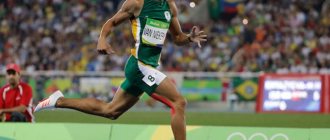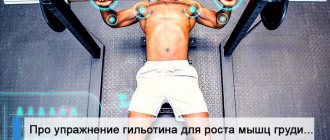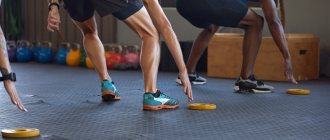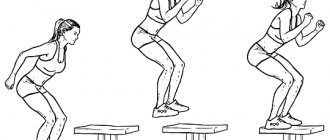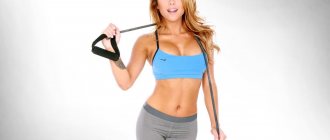Long and high jump are one of the most popular disciplines in athletics. Jumping training can begin at the age of 8-10 years, with a basic level of general physical fitness and good health. At first, everyone is accepted into the section, but over time, the coach retains only those who demonstrate outstanding results. Every centimeter is important for a jumper, so training is hard work.
To improve the results achieved, sometimes months of intensive training are required. But the effort will certainly pay off. Already in adolescence, promising jumpers become participants in competitions at the regional, federal and international levels. Even if a child does not become a professional athlete, jumping is one of the best ways to become slim and fit, develop quick reactions, become agile, courageous and disciplined.
Features of standing jumps
Classic standing long jump is an independent type of competition when passing physical education standards at school. They are also often included in track and field all-around programs or are a separate exercise for harmonious athletic development. Having mastered how to do a standing long jump, you will be able to develop speed and strength qualities, jumping ability, and sprinting skills.
Before analyzing the standing jumping technique, you need to understand a little about what kind of exercise it is. Since school, we know that this exercise is performed by simultaneously lifting off the surface of the legs, and the goal of the jumper is to cover the maximum distance in flight. Having reached contact with the ground, the jumper straightens up and leaves the landing zone. The length of the jump is then measured. This is done along the perpendicular between the extreme lift-off point and the landing. The point of contact in this case is the closest place of landing by any part of the body. There are standards that allow you to objectively assess the physical fitness of a jumper:
- For schoolchildren 8-10 years old, the norm is 120-160 cm.
- Schoolchildren 11-15 years old – 150-200 centimeters.
- For boys and men aged 16-30 years – 200-240 cm.
For female representatives, these same standards are reduced by 10%.
Age categories remain the same. Now let's take a closer look at the step-by-step technique of how to properly perform a standing long jump.
Preparing for the jump
The initial stage, which involves accepting the starting position. It is quite important, as it determines the strength of the push and the overall result of the jump. To take the correct position, the following actions are required:
- You need to stand at the starting line.
- Your legs should be positioned at shoulder level.
- Lower your arms down and move them back a little. Bend your elbows so that you can push your body forward.
- Place your legs on the entire foot.
- Bend your knees and hips so that they are level with your toes.
Repulsion
This stage is performed immediately after the previous one, without stopping, when the body is still moving downward by inertia, and the hip joints begin to unbend. The arms are thrown forward in the direction of the jump. The second phase of the exercise is performed as follows:
- Hands are thrown forward sharply.
- The hip joints are pulled forward.
- The knee joints are extended.
- With an explosive movement, the feet lift off the ground.
Flight and landing
When the athlete is in the air, he pulls his knee joints towards his chest and extends his body in a straight line. At the end of the flight stage, the arms are lowered and the feet are brought forward. Then contact with the ground occurs and the jumper lands. During flight and landing the following movements are made:
- When contacting the surface, you need to bring your hands forward to make it easier to maintain balance.
- The knees bend to ensure a firm landing. At the same time, the load on joints and ligaments is reduced.
- When landing, the athlete needs to straighten up and leave the exercise area.
To perform a good standing long jump, do not land with your legs straight as this can cause injury to your knee joints. It is also important to first work through the above stages separately, and only then proceed directly to full-fledged jumps.
Direct preparation for the jump
There are several steps here:
- we stand on the jump line;
- We place our feet shoulder-width apart;
- bend your lower back and raise your arms up;
- we make the jump.
The landing phase is important - we bend our legs and stand for balance, shifting the body forward. Helps you avoid injury. In the final stage of the jump, it is important not to forget to let your hands go down. It is also absolutely unacceptable to land on straight legs!
Using simple and understandable recommendations, you will be able to improve your high sports results, reaching considerable heights in this direction!
Mistakes when performing standing jumps
Both schoolchildren and experienced athletes in the process of performing standing jumps can make typical mistakes that worsen the results. Among them are the following:
- Uncoordinated movement of arms and legs.
- Premature drop of the legs.
- Incomplete straightening of the knee and hip joints.
- Falling upon contact with the ground.
It is also important to remember the warm-up and its importance . It is needed to prevent injury. You also need to take into account that you can learn to jump long jump from a standing position if your legs and shoulders are sufficiently developed, and your general physical fitness is at a good level. Therefore, it is important to take care of improving strength parameters in general.
There are also other recommendations that will help you jump far and correctly:
- Be sure to study your jumping technique - it must be perfect.
- Strengthen your upper body muscles through strength training exercises.
- Run more.
- Train other types of jumps: high jumps, running jumps, and so on.
- Do stretching exercises every day.
- Track your progress to further improve your achievements.
Process Features
Tests are carried out in a special jump sector equipped with the necessary equipment. Shoes should not slip on the surface. The participant stands near the take-off line, takes the starting position and performs the jump. The judge monitors compliance with the rules of the competition. Measurements are taken from the take-off line to the landing point. Traces left not only by the feet, but also by any other part of the participant’s body are taken into account. If the jump was not made straight, but diagonally, then a perpendicular line is drawn from the landing site to the length measurement scale. Therefore, the correct technique for performing a standing jump is very important.
The jumper is given 3 attempts, the best one counts. The result is not counted in the following cases:
- Stepping behind the line and touching it when pushing off.
- Repulsion does not occur with both legs at the same time, but alternately.
- The jump is performed from a hop.
Standing triple jump: execution technique
There is another type of standing jump - triple jump. It can also be performed with a running start. This jump is included in the program of all athletics competitions. The technique for its implementation is divided into the following stages:
- Two-legged push-off for the first time.
- Flight at the first step.
- Second repulsion.
- Flight during the second step.
- Third repulsion.
- Third flight.
- Landing on your feet.
When performing a triple jump, you need to alternate your legs: push with both legs, left, right, left leg, and then land on both legs. During the first take-off, the same actions are performed as during normal long jumps. Then you need to throw one leg forward, bending it at the knee joint. Make sure your shin points down and slightly forward.
The second leg, which is slightly bent at the knee, is held back. Then you need to land on your front foot with a “raking” motion. The back leg is brought forward through a sharp swing, and then a second push-off is performed.
The second flight stage begins on the other leg . Then, thanks to the new “raking” movement, the repulsion is made a third time. During the last flight, you need to pull the pushing leg towards the fly leg, bend them at the knee and bring them closer to the chest. Then you need to land using the classic standing jumping technique.
To perform this exercise as effectively as possible, you need to push strongly and perform a swinging movement. Try to lengthen the flight phase and do not lower the swing leg to the ground too quickly when taking off.
07:02:19 Altitude 300 meters
If, after falling out of the plane, you started reading this article, then by now you have reached just these lines. You've already got the basics down, and now it's time to pull yourself together and focus on the task at hand. However, here is some additional information. Statistics show that in the event of a disaster, it is more profitable to be a member of the crew or a child, and if there is a choice, it is better to crash on a military aircraft. Over the past 40 years, there have been at least 12 plane crashes with only one survivor. On this list, four were crew members and seven were passengers under the age of 18. Among the survivors is Mohammed el-Fateh Osman, a two-year-old child who survived the Boeing crash in Sudan in 2003 by landing in the wreckage. Last June, when a Yemenia Airways jet crashed near the Comoros Islands, 14-year-old Bahia Bakari was the only survivor.
The survival of crew members can be associated with more reliable passive safety systems, but it is not yet clear why children are more likely to survive. FAA research notes that children, especially those under four years of age, have more flexible bones, more relaxed muscles and a higher percentage of subcutaneous fat, which effectively protects internal organs. Small people—as long as their head does not protrude from the backs of airplane seats—are well protected from flying debris. With a small body weight, the steady-state fall speed will be lower, and a smaller frontal cross-section reduces the chance of running into some sharp object when landing.
Running long jump
The running long jump is a fairly complex exercise, taking into account the technique of execution. The main difficulty is that the exercise consists of several stages that are not repeated. To achieve maximum results, you need to perform them as powerfully as possible.
In any type of jump there are four stages: run-up, take-off, flight and landing. During the flight, three types of jump can be used: with bent legs, with bending and “scissors”. To get maximum results, you need to know how to perform a running long jump correctly. It is recommended to adhere to the following tips :
- During the run, you need to gain maximum speed and maintain it during take-off.
- When pushing off, you need to change the horizontal movement of the body to the correct angle so that the take-off speed is maintained.
- Next, the jumper prepares himself for landing, continuing to adhere to the chosen method of flight.
- When in contact with the ground, you must move your feet forward and upward as much as possible to prevent falling.
For men it is usually recommended to use a distance of 50 meters for a run-up, for women – 35-40. This allows you to gain maximum speed before pushing off. But everything is individual, and each athlete can choose the distance for himself.
Today, professional athletes use one of three types of changing the dynamics of running speed:
- Speed gradually increases from the start of the run and increases sharply before the push.
- An active increase in speed in the middle of the distance, which is replaced by the so-called able run before making a pushing movement.
- A quick start, in which the speed gained is achieved in the middle of the distance and increases sharply before repulsion.
The last method is the most popular, as it makes it possible to gain maximum speed. When flying, the athlete needs to maintain balance and create an optimal starting position before landing. Although at first everything may seem simple, in practice the flight phase is quite complex and greatly influences the final results.
It has already been said that there are three variations of running jumps. Some athletes combine scissors and backbends, and this often leads to very good results. Of course, the technique becomes more complicated, since a combination of several elements is always more difficult to master than one technique. Remember that you cannot land on straight legs - this can lead to knee injury. To learn how to perform an exercise correctly from a technical point of view, you need to prepare yourself for serious work.
Preparatory training
In order to learn how to jump far, it is necessary to first prepare and strengthen the leg muscles, and immediately before jumping, be sure to warm up.
Training and doing exercises such as:
- Barbell squats using medium weight.
- Barbell or dumbbell calf raises.
- Lunges with weights.
- Jumping on a bench or pommel horse.
- Jumping up from a full squat.
- Running with jumping.
- Triple long jump.
Features of proper training for long jumps
To learn how to long jump far, both from a standing position and from a run-up, you need to push off strongly and develop maximum speed (if we are talking about a run-up). Therefore, you need to improve your general physical fitness. In addition, experts recommend performing the following exercises:
- Running with maximum hip lift: 20 times on each leg at a slow pace, and then at medium speed. Then you need to try to develop the highest possible speed.
- It is important to train your arms - this will help give your body maximum acceleration. You need to stand up, bend your legs slightly and swing your arms vigorously, just like you do when running. It is recommended to do several approaches.
- Plyometric training will be useful. Do several alternating sets: first jumping up onto a hill, then jumping off, alternating explosive jumps with long-distance jumps. It is important to ensure that the push is correct.
- To train repulsion strength, you need to exercise with weights. So, you can walk around the gym with a barbell or barbell on your shoulders, paying attention to the fact that at the maximum point of extension the pushing leg straightens, and the thigh of the swing leg becomes parallel to the floor during the step.
Long jumps are quite complex from a technical point of view, so initially it is important not to chase results, but to master the technique of execution. It may not be so fast, but after some time of regular training you will succeed.
The main thing is charging
Warm-up is the very first thing you need to do in any workout. If you do not warm up your muscles, then during subsequent jumping training you can seriously damage your joints or ligaments. On the Internet, and indeed in any gym, they can tell you a huge number of exercises that will warm up your body. The leg muscles need to be developed especially well. You need to slowly squat 20 times and do the same number of raises on your toes. Now you can rotate each leg 10 times inward and outward. You can also walk in single file for a few minutes.
